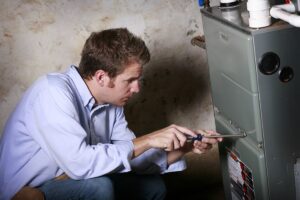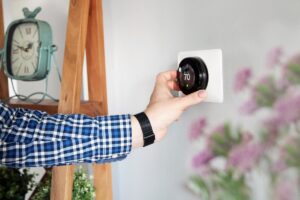Although no one particularly wants to deal with extensive water damage, it is one of the most common problems a home can have. Furnace leaks are one of the leading causes of this; unfortunately, they are also one of the most difficult to spot and fix. These leaks can cause equipment damage and mold growth, affecting your family’s health and your budget.

If a furnace leak is left unchecked, your system can fail and must be replaced. That is why it is essential to recognize the signs of a furnace leak and know how to fix it. You can avoid severe damage to your furnace and home by tackling the problem early.
How Does My Gas Furnace Work, And Does it Give Off Water?
What does water have to do with your gas furnace? Well, actually, a lot. Your gas furnace works by pulling in air from your home and heating it up before sending it back out through the vents.
The process begins when the indoor temperature drops below the set temperature on your thermostat; the thermostat sends a signal to the control board within the furnace to start the heating process. The control board then turns on the furnace’s gas valve and ignites the burner. This warms the heat exchanger, sending its flue gases outside the exhaust pipe. The blower fan then kicks on and forces air over the heat exchanger, this is what you feel coming out of the vents in your home.
Where Does The Water Come From?
Not all furnaces produce water. A conventional or standard efficiency furnace will not produce water as it’s operating, but a high-efficiency furnace (90% efficiency) produces water due to the presence of a second heat exchanger. This explains why a conventional furnace is known as a non-condensing unit while a high-efficiency furnace is known as a condensing unit.
When the burning gas leaves the first heat exchanger, it moves to the secondary heat exchanger. The flue gas goes through additional heat exchange in the second heat exchanger. This is where water vapor is produced. As the water moves from vapor to liquid, more heat is removed from the flue gas and into the secondary heat exchanger. This results in higher efficiency because more heat is extracted from the flue gas. The water that is produced by this process is then drained out through a condensate pump or floor drain.
What Type of Furnace Unit do I Have?
Before we proceed, let’s figure out what type of furnace unit you have in your home. This is not so hard to do. Thereafter, we’ll find out the cause of the leak. If the exhaust pipe is made of white PVC material, then you have a condensing or high-efficiency furnace. If the exhaust pipe is made of metal, then you most likely have a conventional or standard-efficiency furnace.
Why Does Your High-Efficiency Furnace Leak Water?
When a high-efficiency furnace releases the flue gases, condensation occurs. This water then drips down through the PVC pipe before being pumped out of the furnace into the condensation pump or into a floor drain. You find a water leak when this process is not working as it should.
There are a few reasons why this happens:
1. Leaking From Condensate Drain Hose
The drain hose that runs from the furnace PVC exhaust pipe to the floor drain or condensation pump can become blocked with dirt, mold, or rust. When this happens, water backs up and leaks out of the furnace.
2. Inducer Assembly Leaking
When the condensation goes through the exhaust or flue pipe, it goes through the condensate drain hose and then the inducer assembly. The inducer assembly helps to remove the water from the furnace. If it has a crack, it can cause a water leak.
3. Leaking From Condensate Drain Line
Next, the water goes into the condensate drain line. If there is a blockage in the line, holes, cracks, or loose connection, it can cause a water leak.
4. Leaking Out of The Condensate Trap
When the condensate trap is clogged, it can cause a water leak. However, you should realize that not all high-efficiency furnaces have a condensate trap.
5. Condensate Pump Leaking
The condensate finally drains into the condensate pump. If the pump is clogged, it can cause a water leak. A partially or completely blocked drain can also result in a furnace leak. If you spot water anywhere near your high-efficiency furnace, it may be a sign that your furnace has drainage issues. You may also find water stains or rust stains inside the furnace. A faulty pump can also lead to a furnace leak since it causes water backup. You’ll need to get a professional to replace the pump. Condensate pumps have a lifespan of 3 to 5 years.
Why is Your Non-High Efficiency Furnace Leaking Water?
If you have a conventional furnace that runs at standard efficiency, you won’t have to worry about leaking water. But if you find water near or around your conventional furnace, the problem is most likely caused by another appliance. Here are some likely causes:
Leaking From The Air Conditioner
The refrigerant in the air conditioner can cause condensation. This makes it one of the most common causes of a water leak. If you have an air conditioner, check to see if there is any water around it. Here are some reasons why your AC may leak water:
1. Damaged Drain Pan: Your AC unit has a primary drain pan. You’ll find it beneath the evaporator coil. Some units also have a secondary drain pan under the unit. The drain pan is there to catch any condensation. If it is damaged or cracked, it will cause a water leak.
2. Clogged Drain Line: The drain line helps to remove the water that is collected in the pan. If it becomes clogged, water will back up and eventually leak out.
3. A Frozen Evaporator Coil: When the evaporator coil gets too cold, it can cause water to condense on it. This water will then drip down and eventually leak out.
4. Failed Condensate Pump: A condensate pump drains condensation from your HVAC system. If your home has a high-efficiency furnace, then your AC and furnace likely share a condensate pump. If the pump fails, it can cause water to leak from your furnace or AC unit.
Water Leaking From Hot Water Heater
If you have a water heater, it is another common appliance that can cause a water leak. The most common reason for a hot water heater leak is a damaged or corroded tank. This usually happens with older water heaters. A loose drain valve or T&P valve can also cause a water leak.
Water Leaking From The Humidifier
If you have a whole-house humidifier, it can be the source of your water leak. If your HVAC system has a built-in humidifier, it will need water from your home’s plumbing. Over time, the water line can become loose, cracked, broken, or corroded. This can cause a water leak. Regular maintenance can help to prevent this from happening.
Is Furnace Leaking Water Dangerous?
Although a leaking furnace may not be an immediate source of danger, it can eventually lead to some serious problems. For example, if the water leaks onto electrical components, it can cause a fire. If the water leaks onto wooden parts of your home, it can cause rot and mold. And if the leak is bad enough, it could even cause your furnace to stop working. That’s why it is so important to get it fixed as soon as possible.
Water can cause rust in your furnace, which will cause higher inefficiency and eventually lead to a breakdown. If rust causes a hole in your heat exchanger, carbon monoxide could leak into your home or business. A cracked heat exchanger is bad for your health and bank account.
A water leak inside your furnace can also impair the internal electrical components. The circuit board is responsible for directing power to begin the furnace’s heating process. If water gets to it, you’ll have to replace it in no time.
If you don’t attend to a water leak right away, the furnace will have to work harder, which means more wear and tear. This will lead to a breakdown that will expose your household to the cold.
What Should I Do If My Furnace Leaks Water?
The first thing you should do is stay calm and not panic. Then, follow these steps.
Step 1: Turn off the power to your HVAC system.
The first thing you should do is turn off your furnace. This prevents any more water from leaking and damaging it. You can turn off the power to your furnace at the thermostat. You may also do so at the switch on or close to the furnace. If you can’t do any of those things, then you’ll have to turn off the power to the unit at the breaker.
Step 2: Find the source of the water leak and repair it.
Once you’ve turned off the power, you can start to look for the source of the water leak. If you’re not sure where it’s coming from, then call a professional.
Step 2: Clean up all the water near the furnace.
Once you’ve stopped the water leak, you’ll need to clean up all the water that has leaked out. You can use napkins, towels, a mop and bucket, or even a wet vac. Be sure to dry the area completely to prevent any further damage.
Step 3: Turn on the power to your furnace and check for leaks.
After you’ve cleaned up the water and repaired the source of the leak, you can turn on the power to your furnace.
Step 3: Unscrew the front panel of the furnace.
Remove any screws holding the front panel in place. The location of these screws will vary depending on the model of your furnace. Once you’ve removed the screws, pull the panel off to access the inside of the furnace. Clean any water inside if you can. This will help prevent mold growth.
Step 4: Call an HVAC Professional.
Finally, you need to call an HVAC professional to fix the problem for good and to make sure your furnace is safe to use. Water leaking from your furnace is not something you should try to fix on your own. An HVAC professional will be able to diagnose and repair the problem quickly and efficiently.
How Can I Prevent My Furnace From Leaking Water in The Future?
A leaky furnace is frustrating and expensive to repair, but there are some things you can do to prevent it from happening. The best way to prevent your furnace from leaking water is to have it regularly maintained by an HVAC professional. The team at Robert B. Payne can help you with that. We offer a comprehensive maintenance plan that includes a fall and spring tune-up for your furnace. This tune-up will keep your furnace running smoothly and prevent any water leaks. We will be able to clean it, inspect it, and make any necessary repairs.
You should also change your furnace filter regularly. A dirty furnace filter can cause your furnace to overheat and break down. It can also cause the heat exchanger to crack, which can lead to water leaks.
Contact Robert B. Payne if Your Furnace is Leaking Water
If you already have a water leak, then the best thing to do is turn off your furnace and call Robert B. Payne. We will send a team of qualified HVAC technicians to your home to fix the problem quickly and efficiently. We’re here to help, so don’t hesitate to give us a call at 540-373-5876.






